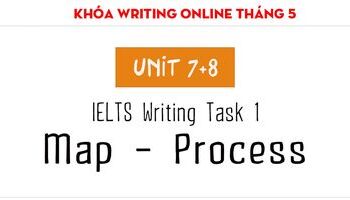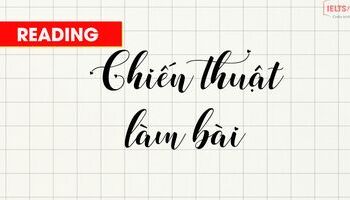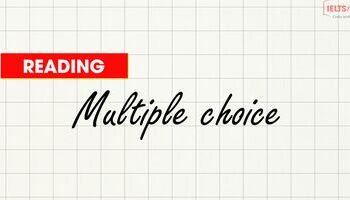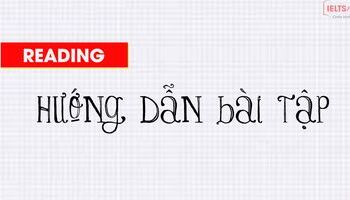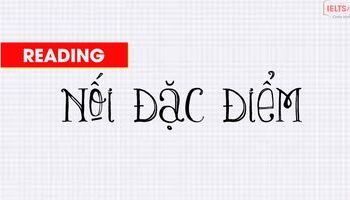Map là dạng bài quen thuộc trong IELTS Writing Task 1 mà người học hay bối rối. Bởi vì có nhiều dạng bản đồ và cần viết bài ra sao tổng quan chuẩn mà đạt điểm cao. Bài học hôm nay sẽ cung cấp cho các bạn một số cấu trúc, hướng dẫn cách viết hay nhé.
CÁCH VIẾT MAPS IELTS WRITING TASK 1
I. VIDEO BÀI GIẢNG
II. KIẾN THỨC BÀI HỌC
1. Các dạng bản đồ thường gặp và câu hỏi
- Describe one map

(Source: IELTS Buddy)
Đây là dạng bài miêu tả biểu đồ đơn. Dạng bài này hiếm khi xuất hiện và thường chỉ yêu cầu người viết sử dụng thì hiện tại đơn
- Describe two maps
(Source: Cambridge English Practice Papers.)
Đây là dạng bài miêu tả biểu đồ đôi. Dạng bài này xuất hiện thường xuyên hơn và thường yêu cầu người viết miêu tả sự thay đổi của một địa điểm giữa quá khứ và hiện tại hoặc giữa hiện tại và tương lai.
Vì dạng bản đồ đơn ít xuất hiện hơn trong đề thi IELTS Writing nên bài học này chúng ta sẽ tập trung tìm hiểu về bản đồ kép các bạn nhé!
NHỮNG ĐIỀU CẦN LƯU Ý
- Sử dụng dạng bị động để miêu tả bởi sự thay đổi của các công trình là do con người tạo ra, chứ không tự nhiên có thêm và mất đi.
- Chia bản đồ thành các khu vực lớn để miêu tả
- Thời gian sử dụng trong bản đồ
2. Cấu trúc bài viết
Bài thi dạng bản đồ cũng có cấu trúc làm bài giống như những dạng khác trong Task 1:
Paragraph 1: Introductn
- Paragraph 2: Overview:
- Paragraph 3: Detail 1
- Paragraph 4: Detail 2
3. Cách lựa chọn thông tin chính
a. Lựa chọn thông tin cho phần Overview
Chọn ra những điểm khác biệt nổi bật ở hai bản đồ và viết hai câu khái quát về đặc điểm nổi bật đó. Bạn có thể dựa vào những câu hỏi dưới đây để tìm ra sự khác biệt:
- Is the map more or less residential?
Khu vực dân cư trong bản đồ tăng lên hay giảm bớt?
- Is the map more or less countryside?
Khu vực nông thông trong bản đồ tăng lên hay giảm bớt đi?
- Are there more or less tree?
Cây cối tăng lên hay giảm đi?
- Were the change dramatic or negligible?
Sự thay đổi có đáng kể hay không?
- Were there any major improvements in infrastructure?
Cơ sở hạ tầng có thay đổi gì lớn hay không?
- How have the buildings and leisure facilities changed?
Các toà nhà và các khu giải trí có thay đổi như thế nào?
Example:
The two maps below show an island, before and after the construction of some tourist facilities.
Summarise the information by selecting and reporting the main features, and make comparison where relevant.
Write at least 150 words
-> Phân tích:
- Ở bản đồ thứ nhất, đảo dài khoảng 250m, có một vài cây cộ xung quang, bao bọc bởi biển và có một bãi biển nhỏ ở phía Tây.
- Ở bản đồ thứ hai, ta thấy xuất hiện khách sạn và bến tàu nhỏ và một phần lớn đảo ở phía đông không thay đổi.
-> Sample overview:
The island is approximately 250 metres long, has palm trees dotted around it, is surrounded by ocean and has a beach to the west. Over the period, the island was completely transformed with the addition of a hotel and a pier; however, the eastern part of the island appears to have been left undeveloped.
(Nguồn: ieltsadvantage.com)
b. Cách lựa chọn thông tin cho phần Body:
Trong đoạn thân bài, ta sẽ chia làm hai đoạn, mỗi đoạn từ 3-4 câu để miêu tả cụ thể hơn về sự thay đổi trong hai bản đồ.
- Với dạng bài miêu tả bản đồ kép, ta có thể chia hai đoạn thân bài để miêu tả thời điểm trước khi có sự thay đổi và sau khi có sự thay đổi. Cách làm này áp dụng với những bản đồ kép có chứa ít thông tin bởi nó đảm bảo sự bao quá thông tin cũng như độ dài của bài viết
- Ngoài ra ta cũng có thể chia hai đoạn thân bài miêu tả các khu vực lớn của bản đồ
- Đối với bản đồ có đường chính (main road), ta lấy đường đó là mốc và chia bản đồ thành hai phần để miêu tả
Example:
The two maps below show an island, before and after the construction of some tourist facilities.
Summarise the information by selecting and reporting the main features, and make comparison where relevant.
Write at least 150 words.

-> Phân tích:
Đối với ví dụ trên, ta sẽ chia bản đồ thành hai khu vực lớn, đó là khu vực trung tâm đảo và khu vực ven đảo
- Mọc thêm một khu nghỉ dưỡng và một bến tàu
- Một góc lớn phía đông của đảo được giữ nguyên
- Khu nghỉ dưỡng có 2 khu phòng ở 2 bên, 1 nhà hàng, 1 khu vực đón tiếp
- Bãi biển phía tây được giữ nguyên và để làm khu bơi lội
- Một số cây cối được giữ nguyên
-> Sample Body:
The most noticeable additions are the hotel rooms. 6 buildings, surrounding some trees, have been built in the west of the island and 9 buildings have been constructed in the centre of the island. Between the two accommodation areas, a reception building and a restaurant have been developed.
A pier has also been built on the south coast of the island, allowing yachts access to the resort. Apart from the trees, the beach remains the only natural feature to remain relatively untouched; however, it does appear that it is now used for swimming.
(Nguồn: ieltsadvantage.com)
4. Ngôn ngữ miêu tả bản đồ
a. Miêu tả sự thay đổi tổng quan
Trong phần tổng quan, khi viết về sự thay đổi ta thường dùng thì HIỆN TẠI HOÀN THÀNH và dạng BỊ ĐỘNG của thì này để mô tả.
Các cụm từ chỉ thời gian cũng được sử dụng như sau:
- over the 20 year period....
- from 1990 to 2000....
- over the years...
- in the last 10 years...
- in the years after 1990...
Các mẫu câu viết tổng quan:
Over the period, the area witnessed dramatic changes.
- From 1995 to 2005, the city centre saw spectacular developments.
- The village changed considerably over the time period.
- During the 10 year period, the industrial area was totally transformed.
- Over the past 20 years, the residential area was totally reconstructed.
- Over the time period, the old docks were totally redeveloped.
- Between 1995 and 2005, the old houses were rebuilt.
- The central business district was completely modernised during the time period
b. Miêu tả sự thay đổi cụ thể
| Expanding | Removing | Additions | Change into something |
| Enlarged Expanded Extended Made bigger Developed | Demolished Knocked down Pulled down Flattened Removed Torn down Cleared (tree, forest) Cut down (tree, forest) Chopped dowwn (tree, forest) | Constructed Build Erected Introduced Added Planted (tree, forest) Opened up (facilities) Set up (facilities) | Converted Redeveloped Replaced Made into Mordernised Renovated Relocated |
Example:
- The factory in the city centre was demolished and relocated to the north of the city.
- The trees were cleared to make way for houses
- The main road was extended and a new bridge built over the river.
- A skate park was set up next to the swimming pool.
c. Miêu tả vị trí
Để chỉ PHƯƠNG HƯỚNG, chúng ta sử dụng những cụm từ sau
- to the north of
- to the east of
- in the west
- to the south of
- to the north west of
- to the north east
- to the south east of
- to the south west of
Example:
- The trees to the north of the river were cut down and a new office block was built.
- A railway was constructed to the east of the housing estate with the introduction of a new train station.
Ngoài ra chúng ta cũng cần sử dụng GIỚI TỪ để miêu tả vị trí:
- on
- next to
- near
- from north to south
- from east to west
- by
- across from
- nearby
- between
- beside
- over
- along
Example:
- Parking facilities were added in the city centre.
- The school across from the park was extended and new sports facilities were built.
Thế là chúng ta đã tìm hiểu phần Wring Task 1 dạng Map - Bản đồ.
III. BÀI TẬP
Exercise 1: Fill in the blank (Sử dụng từ ở mục miêu tả sự thay đổi cụ thể)
- The offices were .... and the surrounding area was with a new leisure centre opening up.
- The shopping centre was .... and the parking area was to accommodate more cars
- The trees were ... and a new office block was .
- A railway was ... with the introduction of a new train station.
- The industrial area was ... and ... with lots of new factories being built.
- The local government had the sports facilities ... and the small park was a children’s playground.
- The park was ....with a new housing complex.
Exercise 2: Fill in the blanks (Sử dụng từ ở mục miêu tả vị trí)
- Dramatic changes took place ________the city centre.
- To the south of the town, there is a golf course surrounded _______
- A new school was built _______the swimming pool.
- The old road running ______ north ______ south was replaced by a new motorway.
- A marina was built ______the banks of the river.
PART 2: PROCESS
I. VIDEO BÀI GIẢNG
II. KIẾN THỨC HỌC TẬP
1. Các câu hỏi thường gặp
Chúng ta có hai dạng quá trình thường gặp: Quá trình tự nhiên và Quá trình nhân tạo
| Tên | Định nghĩa | Hình ảnh |
| Quá trình tự nhiên (Natural Process) | Bao gồm các quá trình như vòng đời của ếch, sự tuần hoàn của nước, quá trình mang thai, hay bò cho sữa như thế nào, v.v…. |  |
| Quá trình nhân tạo (Man-made Process) | Bao gồm các quá trình như cách làm cà phê, bia hay rượu vang, cách sản xuất xi măng và gạch, v.v…. |  |
*Lưu ý:
- Dùng dạng CHỦ ĐỘNG để mô tả quá trình tự nhiên
- Dùng dạng BỊ ĐỘNG để mô tả quá trình nhân tạo
2. Các bước làm bài
Bước 1: Quan sát kỹ hình vẽ. Tìm ra điểm bắt đầu và điểm kết thúc của quá trình, xác định có bao nhiêu giai đoạn trong quá trình, các bước là gì và mỗi liên hệ giữa các giai đoạn.
Bước 2: Viết Introduction
Bước 3: Viết đoạn Overview
Bước 4: Viết đoạn Body
Bước 5: Kiểm tra lại bài viết
CỤ THỂ
Bước 1:
Một trong những khó khăn khi làm dạng bài này đó là chúng ta phải viết về những thứ chúng ta chưa gặp hay chưa đọc về nó bao giờ.
Tuy nhiên hãy nhớ rằng, để hiểu rõ về quá trình, chúng có list các câu hỏi như sau:
- Quá trình bắt đầu và kết thúc ở đâu?
- Có bao nhiêu giai đoạn?
- Đây là quá trình tự nhiên hay quá trình nhân tạo?
- Quá trình sản xuất gì?
- Chức năng của từng giai đoạn là gì?
- Mối quan hệ giữa các bước của quá trình
Bước 2: Viết Introduction
Bước này hoàn toàn tương tự nhau ở các dạng bài trong Writing task 1. Các bạn có thể xem lại ở những bài học trước.
Bước 3: Viết tổng quan
Các bạn có thể dễ dàng viết được một đoạn tổng quan bằng cách tham khảo một số những câu hỏi dưới đây để chọn thông tin:
- Đây là quá trình tự nhiên hay quá trình nhân tạo?
- Quá trình gồm bao nhiêu giai đoạn?
- Quá trình này sản xuất gì
- Quá trình bắt đầu và kết thúc ở đâu?
- Đây là chu trình tuần hoàn hay bắt đầu và kết thúc ở các điểm khác nhau?
- Có nguyên liệu hay chất liệu gì thêm vào không?
Example:
The diagram below shows how the Australian Bureau of Meteorology collects up-to-the-minute information on the weather in order to produce reliable forecasts.

Phân tích:
- Đây là quá trình nhân tạo
- Quá trình thu thập và làm ra thông tin để phát sóng
- Gồm 4 giai đoạn: tiếp nhận, phân tích, chuẩn bị, phát sóng
Sample Overview:
There are four stages in the process, beginning with the collection of information about the weather. This information is then analysed, prepared for presentation, and finally broadcast to the public.
(Nguồn: ielts-simon.com)
Bước 4: Viết đoạn thân bài
Trong phần thân bài của dạng Process, không giống như các dạng khác là chọn lọc thông tin để mô tả, ta cần phải đề cập đến tất cả các giai đoạn của quá trình. Chúng ta sẽ lần lượt miêu tả từ giai đoạn đầu tiên, các giai đoạn kế tiếp cho đến giai đoan kết thúc.
Example:
The diagram below shows how the Australian Bureau of Meteorology collects up-to-the-minute information on the weather in order to produce reliable forecasts.

Phân tích:
- Có ba cách để thu thập thông tin: satellite, radar, drifting buoy.
- Các thông tin lần lượt được hiển thị theo ba dạng ảnh vệ tinh (satellite photo), màn hình radar (radar screen), bản đồ thời tiết (synoptic chart) để phân tích, dự đoán và sẽ được chuẩn bị lên sóng
- Cuối cùng, thông tin sẽ được chuẩn bị qua máy tính
Sample Body:
Looking at the first and second stages of the process, there are three ways of collecting weather data and three ways of analysing it. Firstly, incoming information can be received by satellite and presented for analysis as a satellite photo. The same data can also be passed to a radar station and presented on a radar screen or synoptic chart. Secondly, incoming information may be collected directly by radar and analysed on a radar screen or synoptic chart. Finally, drifting buoys also receive data which can be shown on a synoptic chart.
At the third stage of the process, the weather broadcast is prepared on computers. Finally, it is delivered to the public on television, on the radio, or as a recorded telephone announcement.
(Nguồn: ielts-simon.com)
3. Ngôn ngữ miêu tả quá trình
Không giống như những các dạng bài graphs hay maps miêu tả về xu hướng và sự thay đổi, đối với dạng bài quá trình, ta cũng cần có những ngôn ngữ miêu tả riêng. Đó chính là “SEQUENCERS” (ngôn ngữ trình tự).
- First of all/ Firstly…
- The first step/stage is…
- Next/Then/After that…
- Finally/In the final step/In the final stage is
- Before/After/Once
III. BÀI TẬP
1. Exercise: Choose the correct word to fill in the blanks
| Eventually Beginning at At the second stage At the third stage Before |

Three main stages are shown on the diagram. Ocean water evaporates, falls as rain, and ____________ runs back into the oceans again.
____________ the evaporation stage, we can see that 80% of water vapour in the air comes from the oceans. Heat from the sun causes water to evaporate, and water vapour condenses to form clouds. _____________, labelled ‘precipitation’ on the diagram, water falls as rain or snow.
______________ in the cycle, rainwater may take various paths. Some of it may fall into lakes or return to the oceans via ‘surface runoff’. Otherwise, rainwater may filter through the ground, reaching the impervious layer of the earth. Salt water intrusion is shown to take place just _______ groundwater passes into the oceans to complete the cycle.
(Nguồn: ielts-simon.com)
2. Exercise: Choose the correct word to fill in the blanks
| At the first stage Then Next Following this Finally |
___________ in the paper recycling process, waste paper is collected either from paper banks, where members of the public leave their used paper, or directly from businesses. This paper is _______ sorted by hand and separated according to its grade, with any paper that is not suitable for recycling being removed. ____, the graded paper is transported to a paper mill.
Stages four and five of the process both involve cleaning. The paper is cleaned and pulped, and foreign objects such as staples are taken out. ________, all remnants of ink and glue are removed from the paper at the de-inking stage. _______, the pulp can be processed in a paper making machine, which makes the end product: usable paper.
(Nguồn: ielts-simon.com)
Tham khảo thêm bài học:
IELTS Writing Task 1 dạng Line graph - Pie chart - Bar graph - Tables
Hướng dẫn viết IELTS Writing toàn diện cho người mới bắt đầu
Chúc các bạn học tốt ^-^
